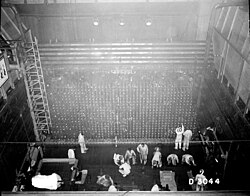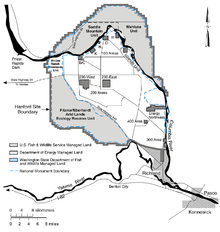B Reactor
|
Hanford B Reactor
|
|

The face of B Reactor during construction.
|
|
| Location | Near junction of WA 24 & WA 240 on the Hanford Site |
|---|---|
| Nearest city | Richland, Washington |
| Built | June 7, 1943[1] to September 1944[2] |
| Architect | E.I. DuPont de Nemours & Co. |
| NRHP Reference # | 92000245 |
| Significant dates | |
| Added to NRHP | April 3, 1992 |
| Designated NHL | August 19, 2008[3] |
The B Reactor at the Hanford Site, near Richland, Washington, was the first large-scale nuclear reactor ever built. The project was commissioned to produce plutonium-239 by neutron activation as part of the Manhattan Project, the United States nuclear weapons development program during World War II. The B reactor was fueled with metallic natural uranium, graphite moderated, and water-cooled. It has been designated a U.S. National Historic Landmark since August 19, 2008[3][4] and in July 2011 the National Park Service recommended that the B Reactor be included in the Manhattan Project National Historical Park commemorating the Manhattan Project.[5] Visitors can take a tour of the reactor by advance reservation.[6]
Contents
Reactor design and construction[edit]
The reactor was designed and built by E. I. du Pont de Nemours and Company based on experimental designs tested by Enrico Fermi at the University of Chicago, and tests from the X-10 Graphite Reactor at Oak Ridge National Laboratory. It was designed to operate at 250 megawatts (thermal).
The reactor occupies a footprint of 46 by 38 ft (14 by 12 m) (about 1,750 sq ft (163 m2) and is 41 ft (12 m) (approximately five stories) tall, occupying a volume of 71,500 cu ft (2,020 m3). The reactor core itself consisted of a 36-foot-tall (11 m) graphite box measuring 28 by 36 ft (8.5 by 11.0 m) occupying a volume of 36,288 cu ft (1,027.6 m3) and weighing 1,200 short tons (1,100 t). It was penetrated horizontally through its entire length by 2,004 aluminum tubes and vertically by channels for the vertical safety rods.[4]
The core is surrounded by a thermal shield of cast iron 8 to 10 inches (20 to 25 cm) thick weighing 1,000 short tons (910 t). Masonite and steel plates enclose the thermal shield on its top and sides, forming a biological shield for radiation protection. The bottom of the thermal shield is supported by a 23-foot-thick (7.0 m) concrete pad topped by cast-iron blocks. The graphite composition was selected to moderate the nuclear reaction fueled by 200 short tons (180 t) of uranium slugs approximately 25 mm (1 in) diameter 70 mm (3 in) long (the approximate size of a roll of quarters[4]), sealed in aluminum cans, and loaded into the aluminum tubes.[4]
The reactor was water-cooled, with cooling water pumped from the Hanford Reach of the Columbia River through the aluminum tubes around the uranium slugs at the rate of 75,000 US gal (280,000 L) per minute. The water was discharged into settling basins, then returned to the river after allowing time for the decay of radioactive materials, the settling out of particulate matter and for the water to cool so it could be returned to the Columbia River. Water returning to the river was prohibited to raise the temperature of the river no more than 11 °F.[7]

Reactor operation[edit]
The B Reactor had its first nuclear chain reaction in September, 1944, the D Reactor in December 1944 and the F Reactor in February 1945. The reactor produced plutonium-239 by irradiating uranium-238 with neutrons generated by the nuclear reaction. It was one of three reactors – along with the D and F reactors – built about six miles (10 km) apart on the south bank of the Columbia River. Each reactor had its own auxiliary facilities that included a river pump house, large storage and settling basins, a filtration plant, large motor-driven pumps for delivering water to the face of the pile, and facilities for emergency cooling in case of a power failure.[4]
Emergency shutdown of the reactor, referred to as a SCRAM, was attained either by rapidly fully inserting the vertical safety rods (now called control rods) or, as a backup method, by the injection of borated water into the reactor. In January 1952, the borated water system was replaced by a "Ball-3X" system that injected nickel-plated high-boron steel balls into the channels occupied by the vertical safety rods.[4]
The plutonium for the nuclear bomb used in the Trinity test in New Mexico and the Fat Man bomb dropped on Nagasaki, Japan was created in the B, D, and F reactors. These first three reactors ran for two decades, and were joined by additional reactors constructed later. The B Reactor was permanently shut down in February 1968.[4]
Current status[edit]
B Reactor is now in "interim safe storage" status.[citation needed] The D and F reactors were shut down in June 1967 and June 1965, respectively. In a process called cocooning or entombment, the reactor buildings are demolished up to the 4-foot-thick (1.2 m) concrete shield around the reactor core. Any openings are sealed and a new roof is built. The D and F reactors have already been entombed, as have the C and DR reactors. Most auxiliary buildings at the first three reactors have been demolished, as well. The H, K-East and K-West reactors and the N-Reactor are scheduled to be entombed in that order.
The United States Department of Energy has administered the site since 1977 and offers public tours on set dates during the spring, summer, and fall of the year, as well as special tours for visiting officials. The B Reactor was added to the National Register of Historic Places (#92000245) on April 3, 1992, and was named a National Historic Landmark on August 19, 2008.[3][4] It is in the process of conversion into a museum.
Timeline of major events[edit]
| Year | Date | Event |
|---|---|---|
| 1943 | October | U.S. Army Corps of Engineers breaks ground to build B Reactor[8] |
| 1944 | September 13 | First uranium fuel slug loaded into B Reactor[8] |
| 1944 | September 26 | Initial reactor criticality achieved[8] |
| 1945 | February 3 | B Reactor plutonium delivered to Los Alamos[8] |
| 1945 | July 16 | B Reactor plutonium used in world's first nuclear explosion. (Trinity Test Site, New Mexico) [8] |
| 1945 | August 9 | B Reactor plutonium used in Fat Man bomb dropped on Nagasaki, Japan[8] |
| 1946 | March | B Reactor operations suspended[8] |
| 1948 | June | B Reactor operation resumed[8] |
| 1949 | March | B Reactor begins production of tritium for use in hydrogen bombs[8] |
| 1954 | March 1 | First use of B Reactor tritium in a test detonation of a hydrogen bomb at Bikini Atoll[citation needed] |
| 1968 | January 29 | Atomic Energy Commission directs shutdown of B Reactor[8] |
| 1976 | B Reactor declared National Historic Mechanical Engineering Landmark by American Society of Mechanical Engineers[8] | |
| 2008 | B Reactor declared National Historic Landmark by U.S. Department of Interior and National Park Service[8] | |
| 2009 | U.S. Department of Energy announces public tours[9] | |
| 2011 | July | National Park Service recommends B Reactor be included in a national historic park commemorating the Manhattan Project.[5] |
References[edit]
- ^ Shannon Dininny (2008-08-26). "World's first nuclear reactor now a landmark". Associated Press. Archived from the original on 16 September 2008. Retrieved 2008-08-26.
Construction began on June 7, 1943...
- ^ "Department of Energy – B Reactor". United States Department of Energy. 2007-04-20. Archived from the original on 16 September 2008. Retrieved 2008-08-26.
Completed in September 1944...
- ^ a b c "Weekly List Actions". National Park Service. 2008-08-29. Archived from the original on October 31, 2008. Retrieved 2008-08-30.
- ^ a b c d e f g h Michele S. Gerber; Brian Casserly; Frederick L. Brown (February 2007). "National Historic Landmark Nomination: B Reactor / 105-B; The 105-B Building in the 100-B/C Area at Hanford" (PDF). National Park Service. Archived from the original (PDF) on 2012-10-26.
- ^ a b Cary, Annette (13 July 2011). "HANFORD: Park service recommends B Reactor for national park". Tri-City Herald. Retrieved 17 July 2011.[dead link]
- ^ "Tour Information". Manhattan Project: B Reactor. Retrieved 12 November 2015.
- ^ United States Department of Energy. "Hanford Site Virtual Tours: 100-B Area". Hanford Site website. Richland, Washington. Archived from the original on September 17, 2008. Retrieved 2009-10-23.
- ^ a b c d e f g h i j k l Manhattan Project B Reactor: World's first full-scale nuclear reactor, HNF-41115, Rev. 0, US Department of Energy, May 2009
- ^ Manhattan Project B Reactor Tour Information, Feb 14, 2011, archived from the original on 21 July 2011, retrieved 17 July 2011
Further reading[edit]
- Washington Closure Hanford - Project News Volume 1, Issue 04 PDF
- "Hanford Site – Timeline 1943–1990" (PDF). 1997. Archived from the original (PDF) on 2009-02-25.
- History of the 100-B area (PDF) (Report). US DoE. WHC-EP-0273.
External links[edit]
| Wikimedia Commons has media related to Hanford B Reactor. |
- "Ranger in Your Pocket" online tours Atomic Heritage Foundation
- Hanford 25th Anniversary Celebration Video of the 25th anniversary celebration of the construction of B Reactor
- B Reactor Museum Association A collection of Hanford-related documents from a group working to preserve the B-100 Reactor at Hanford.
- Reactor 105-B (museum) location: 46°37′49″N 119°38′51″W / 46.63028°N 119.64750°WCoordinates: 46°37′49″N 119°38′51″W / 46.63028°N 119.64750°W
- Hanford Site Tours – Department of Energy, includes B Reactor
- History of physics
- Hanford Site
- Manhattan Project
- Graphite moderated reactors
- Buildings and structures in Benton County, Washington
- Nuclear history of the United States
- Nuclear weapons infrastructure of the United States
- Military nuclear reactors
- Infrastructure completed in 1944
- National Historic Landmarks in Washington (state)
- Historic Civil Engineering Landmarks
- Museums in Benton County, Washington
- Industrial buildings and structures on the National Register of Historic Places in Washington (state)
- Energy infrastructure on the National Register of Historic Places
- Defunct nuclear reactors
- World War II on the National Register of Historic Places
- National Register of Historic Places in Benton County, Washington
- Cold War museums in the United States


